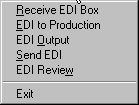|
CSC
Singular Vision,
Simple Solutions. |
 |
|||||||
|
Electronic Data Interchange (EDI) In a traditional
EDI environment the sequence of operation is:
In an error correcting EDI, the traditional separation of translation function and the loading of the data into final database are eliminated. The information flows directly from the mailbox file into the final destination database. The creation of the FA is done on the fly and the actual data verification is done at the same stage. This integrated operation enables the recipient to verify the accuracy of the destination address, checking it against the existing records and inserting new ones if required. It enables to change the addresses of existing drop ship locations, eliminating the need for manual or subsequent adjustments. Usually the prices are prearranged between the buyer and the supplier, and the electronic transmission only reconfirms existing arrangement. You have to accept the prices that are transmitted to you by the buyer. Any change to the prices that comes from 850 is automatically loaded by the error correcting EDI into existing tables, eliminating the need for manual update. New items that are introduced as a result of document 832 exchanges are automatically loaded into your cross-reference files. This arrangement enables a very easy way to retransmit and make corrections to mistakes introduced in packaging and labeling of shipments. As you can see from the Rolodex setup, some of the information required for EDI is embedded in your data processing database.
|
||||||
|
|
|||||||||
| © Crompton Systems Corporation. | |||||||||


